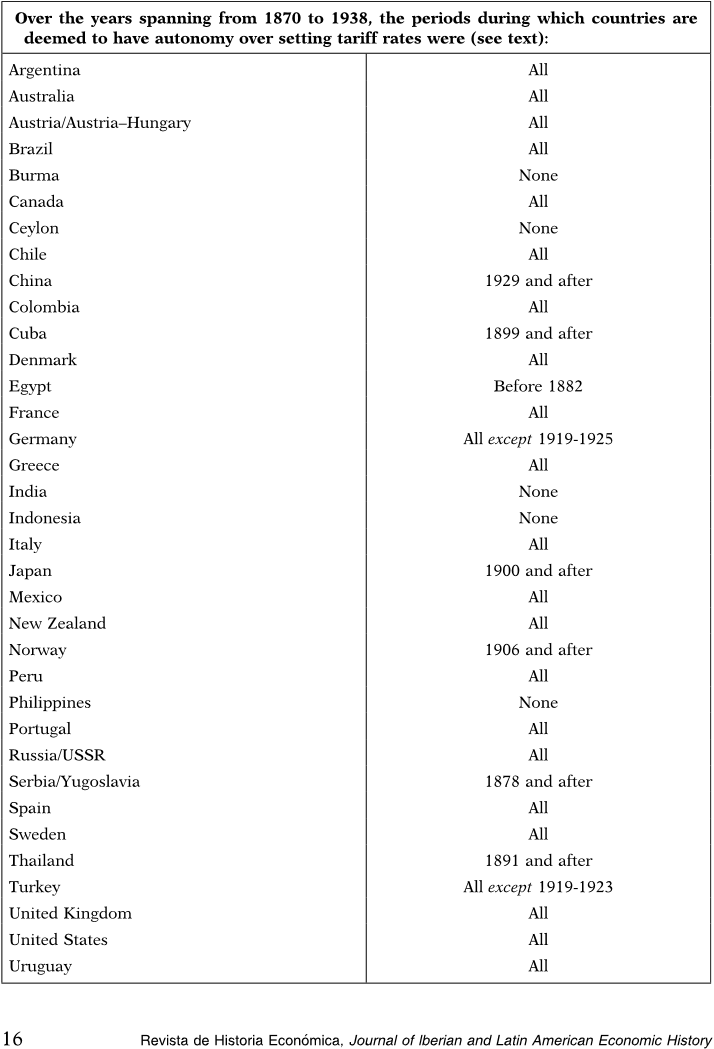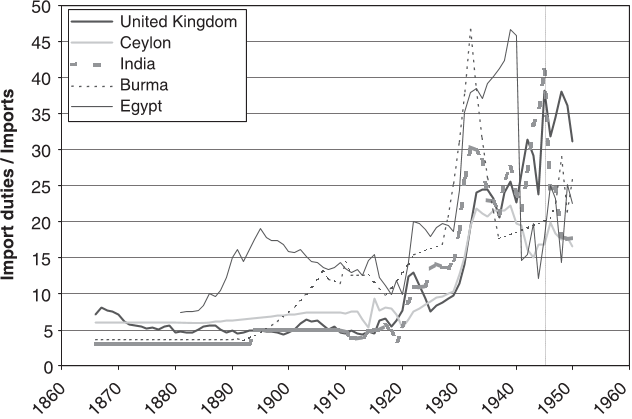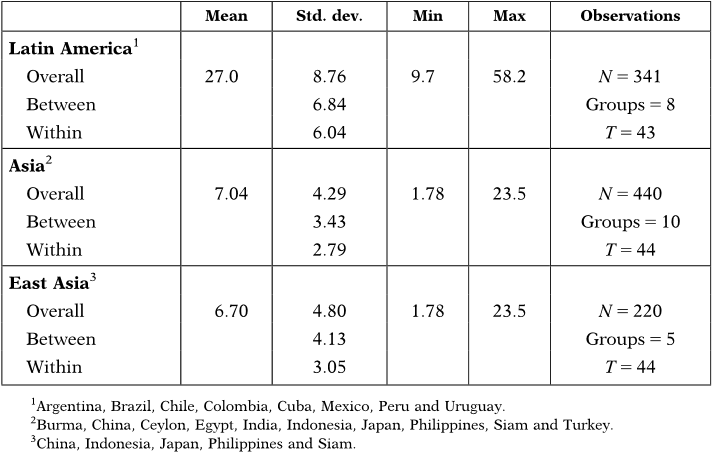
WHY WERE LATIN AMERICA’S TARIFFS SO
MUCH HIGHER THAN ASIA’S BEFORE 1950?*
MICHAEL A. CLEMENS
Center for Global Development
a
JEFFREY G. WILLIAMSON
Harvard University and the University of Wisconsin
b
ABSTRACT
Latin America had the highest tariffs in the world before 1914; Asia had
the lowest. Heavily protected Latin America also boasted some of the most
explosive belle e
´
poque growth, while open Asia registered some of the least.
What brought the two regions to the opposite ends of the tariff policy spectrum?
We find that limits to Asian tariff policy autonomy may have lowered tariffs
substantially there, but by themselves they cannot explain why Asian tariffs
were so much lower than the Latin American tariffs before 1914; that natural
barriers, domestic political economy and strategic tariff policy seems to have
contributed much to the difference and that the origins of Asian post-World
War 2 import-substitution policies seem to lie in the interwar years when Asian
tariff levels caught up with those of Latin America.
Keywords: tariffs, Latin America, Asia, growth, history
JEL Code: F13, N70, O24
RESUMEN
Ame
´
rica Latina tuvo los aranceles ma
´
s altos del mundo antes de 1914;
Asia tuvo los ma
´
s bajos. Fuertemente protegida, Ame
´
rica Latina tambie
´
n
*
Received 12 April 2011. Accepted 19 July 2011.
a
1800 Massachusetts Avenue NW, 3
rd
floor, Washington, DC 20036, USA. mclemens@cgdev.org.
b
350 South Hamilton Street, Unit 1002, Madison, WI 53703, USA. jwilliam@fas.harvard.edu.
Revista de Historia Econo
´
mica, Journal of lberian and Latin American Economic History
Vol. 30, No. 1: 11-44. doi:10.1017/S021261091100019X & Instituto Figuerola, Universidad Carlos III de Madrid, 2011.
11

ofrecio
´
uno de los crecimientos ma
´
s explosivos de la belle e
´
poque mientras
Asia mostraba uno de los menores. +Fue el diferente espectro de la polı
´
tica
arancelaria lo que llevo
´
a estas dos regiones a destinos tan opuestos? Nosotros
encontramos: que los lı
´
mites a la autonomı
´
adelapolı
´
tica arancelaria en Asia
habrı
´
an contribuido considerablemente a reducir los aranceles, pero no pue-
den explicar por sı
´
mismos por que
´
los aranceles fueron mucho ma
´
s bajos que
en Ame
´
rica Latina antes de 1914; las barreras naturales, la economı
´
apolı
´
tica
nacional y las polı
´
ticas arancelarias estrate
´
gicas parecen haber contribuido
mucho a la diferencia en el comportamiento del crecimiento de estas dos zonas
ylosorı
´
genes de la polı
´
tica de sustitucio
´
n de importaciones asia
´
tica posterior a
la II Guerra Mundial parecen extenderse al periodo de entreguerras cuando los
niveles arancelarios asia
´
ticos convergieron con los de Ame
´
rica Latina.
Palabras clave: aranceles, Ame
´
rica Latina, Asia, crecimiento, historia
1. INTRODUCTION
While many have compared Latin American and Asian trade policy since
1950, few have extended the comparison to the preceding century. The best
evidence from the long 19
th
century through World War (WW) 2 reveals
tremendous contrasts between the two regions. These demand explanation.
Latin America had the highest tariffs in the world before 1914; Asia had
the lowest. The Latin American belle e
´
poque also boasted some of the highest
growth rates, while Asia registered some of the lowest. What brought the two
regions to the opposite ends of the tariff policy spectrum? Was it simply that
Latin America had policy autonomy, while most of colonial Asia did not, or
was the political economy of tariffs more complex? Why did Asian tariffs
catch up with those high Latin American tariffs in the 1920s and 1930s? Do
historical patterns of growth and tariff policy in the two regions accord with
recent conventional wisdom that free trade fosters growth?
This paper uses the historical record of tariff policy to begin an
exploration of all of these questions. We use average ad valorem-equivalent
tariff rates and describe their correlates with tariff autonomy and other
political economy forces in the two regions. Average tariff rates cannot, of
course, settle questions about «protection» more generally, which includes
policies other than tariffs, and they lack fine-grained information about
relative protection of different industries. Since overall tariffs differed vastly
between the two regions, they are certainly a good place to begin.
We first describe our tariff database. We use these data to explore the partial
correlations between import duty levels and the conditions under which they
were set — including colonial rule, «unequal treaties», world market condi-
tions, geography and the local political economy environments. We find that
while limits to Asian tariff policy autonomy certainly lowered tariffs there
MICHAEL A. CLEMENS/JEFFREY G. WILLIAMSON
12 Revista de Historia Econo
´
mica, Journal of lberian and Latin American Economic History

substantially, they cannot by themselves explain why Asian tariffs were so
much lower than the Latin American tariffs before 1914; that natural barriers,
domestic political economy and strategic tariff policy seem to have contributed
much to the difference and that the origins of Asian post-WW2 import-sub-
stitution policies seem to lie in the interwar years when Asian tariffs caught up
with those of Latin America. At the end of the paper, we pose a research
agenda: Does tariff policy explain most of the differences in industrialisation
experience within and between the two regions, or did other factors — like
terms of trade trends, the evolution of wage, fuel, and intermediate costs and
productivity catch up with the leaders — matter much more?
2. THE TARIFF DATA
A well-developed international literature makes it clear that trade shares
are very poor measures of openness, since they are endogenous and can be
driven by demand and supply factors within countries that are completely
independent of trade policy
1
. Among the explicit policy measures of openness
available, the average tariff rate is by far the most homogeneous protection
measure and the easiest to collect across countries and over time. We are, of
course, aware that countries can have the same average tariff levels, but very
different tariff structures
2
. Nevertheless, high average tariffs typically meant
even higher tariffs on manufactures in primary-product exporting countries
3
.
We are also aware that by the late 1930s every country had learnt how to use
non-tariff barriers (NTBs), especially the manipulation of the real exchange
rate to favour import-competing industries. However, NTBs were not used
very frequently before the early 1930s, and nearly every country was on a fixed
exchange standard before WW1 and again in the 1920s. In short, tariffs were
the main instrument of trade policy before the 1930s. In any case, high tariffs
were also positively correlated with the use of NTBs. Thus, it seems to us that
1
For example, see Anderson and Neary (1994), Sachs and Warner (1995) and Anderson (1998).
Indeed, it appears that totally 67 per cent of the late 20
th
century Organisation for Economic
Cooperation and Development trade boom can be explained by unusually fast income growth, and
not by the decline in trade barriers (Baier and Bergstrand 2001). To cite another example, 50 to 65
per cent of the European overseas trade boom in the three centuries following 1492 were driven by
income growth, rather than by any decline in trade barriers (O’Rourke and Williamson 2002,
p. 439). As a final example, 57 per cent of the world trade boom from 1870 to 1913 was explained by
the income growth (Estevadeordal et al. 2003, Table III).
2
See, for example, Lehmann and O’Rourke (2011) on 19
th
century Europe, and Nunn and
Trefler (2010) on the 20
th
century world economy.
3
See, for example, Bairoch (1993) and Williamson (2011a, Ch. 13). Antonio Ten
˜
a (personal
correspondence) has estimated ad valorem tariffs on British manufacturing exports for four Latin
American republics in 1914 (Argentina, Brazil, Chile and Mexico): while the tariff for all imports
averaged 21.5 per cent, the average tariff on British manufactures averaged 45 per cent, more than
twice as high. Similarly, for the European periphery (Greece, Italy, Portugal, Russia, Spain): while
the average tariff on all imports in 1914 was 18.4 per cent, the tariff on British manufactures was
46.2 per cent, almost three times higher.
LATIN AMERICA’S TARIFFS VS. ASIA’S PRE-1950
Revista de Historia Econo
´
mica, Journal of lberian and Latin American Economic History
13

as an overall measure of protection, average tariffs are the place to start any
empirical analysis of the political economy of protection, even if they are not
the place to finish it. In addition, while high tariffs may not necessarily be the
result of explicit pro-industrialisation goals, they are protectionist regardless
of their motivation.
This paper uses the computed average tariff rate to explore differences
between Asian and Latin American policy experience from shortly after the mid-
19
th
century to WW2. Our country observations from these two regions are part
of a larger world sample of thirty-five, extending up to 1950: the United States;
three members of the European industrial core (France, Germany and the United
Kingdom); three English-speaking European offshoots (Australia, Canada and
New Zealand); ten from the European periphery (Austria–Hungary, Denmark,
Greece,Italy,Norway,Portugal,Russia,Serbia,SpainandSweden);tenfrom
Asia and the Middle East (Burma, Ceylon, China, Egypt, India, Indonesia, Japan,
the Philippines, Siam (Thailand) and the Ottoman Empire (republican Turkey));
and eight from Latin America (Argentina, Brazil, Chile, Cuba, Colombia, Mexico,
Peru and Uruguay). Standard tariff histories focus mainly on seven — Denmark,
France, Germany, Italy, Sweden, the United Kingdom and the United States.
While the tariff data used here have already been exploited to help redress this
big world research imbalance (O’Rourke and Williamson 2002; Clemens and
Williamson 2004; Coatsworth and Williamson 2004a, 2004b; Williamson 2006b),
this paper does much more by focusing in depth on the ten Asian and eight Latin
American countries in our sample, which represent the poor periphery, and by
exploring the crucial interwar experience as well.
Average tariff rates are calculated as the total revenue from import duties
divided by the value of total imports in the same year. In some cases, the
sources used do not distinguish between import and export duties, and report
only total customs duties. However, total customs duties (instead of import
duties) are used in the calculation of average tariff rates only for countries
where the value of export duties have historically been an insignificant share
of total customs duties. Sometimes, the value of import duties collected is
reported for fiscal years, while import data generally refer to calendar years.
While making a consistent effort to compare calendar year duties with
calendar year import values, in cases where calendar year duties figures are
unavailable, fiscal year duties are divided by calendar year imports to calculate
average tariff. In these instances, fiscal year import duties are assumed to
belong to the calendar year in which most of the fiscal year falls
4
.
The remainder of this paper defines Latin America as the eight-country
sample consisting of Argentina, Brazil, Chile, Colombia, Cuba, Mexico, Peru
and Uruguay. Asia is defined as the ten-country sample consisting of Burma,
China, Ceylon, Egypt, India, Indonesia, Japan, the Philippines, Siam and
4
A complete appendix description of the sources and methods surrounding the tariff database
can be found in Blattman et al . (2002) and Clemens and Williamson (2004).
MICHAEL A. CLEMENS/JEFFREY G. WILLIAMSON
14 Revista de Historia Econo
´
mica, Journal of lberian and Latin American Economic History

Turkey, while East Asia is defined by the sub-sample of China, Indonesia,
Japan, the Philippines and Siam.
3. EXPLORING TARIFF AUTONOMY
Our analysis requires formalisation of the concept of tariff autonomy, the
freedom to set tariff levels independent of another state’s military and poli-
tical power. Table 1 lists the years in which we judge each country to have
had tariff autonomy. Burma, Ceylon and India were subject to British
imperial tariff collection policies, as Cuba was to the Spanish through 1899,
Indonesia (Netherlands Indies) was to the Dutch and the Philippines was to
both the Spanish up to 1898 and the United States thereafter. The British
Foreign Office in China largely eliminated the tariff restrictions imposed by
the treaties of Nanking and Tientsin in 1929. Norway did not have an inde-
pendent tariff policy under the Swedish crown through 1905. Gradual weak-
ening of Ottoman control in Serbia is construed to imply tariff autonomy
following the 1878 Treaty of Berlin. Egypt is taken to hold tariff autonomy
under non-interventionist Ottoman rule during the years prior to the British
invasion of 1882, but not thereafter. Thailand is taken to recover autonomy
from the grasp of the unequal treaties in 1891, following Ingram (1971,
p. 138), and Japan in 1900, following Lockwood (1968, p. 539). We take
Turkey to have lost tariff autonomy in the brief years between its defeat in
WW1 and Mustafa Kemal’s establishment of the Turkish Republic thereafter.
With these definitions of tariff autonomy in mind, we turn next to colonial
tariff policy, followed by tariff policy under gunboat diplomacy.
3.1. Did Asian Colonies Simply Mimic their Masters?
This is a good place to explore the tariff autonomy issue within the
colonies. There are five colonies in our sample, all in Asia: Burma, Ceylon,
India, Indonesia and the Philippines, although foreign influence was strong
enough (including occupation) to make Egypt behave like a colony after 1881
(see, e.g. Owen 1993, p. 122). To what extent did these six simply mimic their
colonial masters?
Figure 1 reveals a clear correlation in timing and magnitudes of change in
tariff rates between the United Kingdom and her four colonies in the sample
(Burma, Ceylon, Egypt and India). Figure 2 shows the same for the Philippines,
first for Spain and then for the United States (becoming the imperialist master
in 1899). Table 2 reports the master colony tariff rate correlations for these four
and for the Philippines
5
. Colonial tariff policy did indeed mimic that of the
5
The Netherlands is not part of our sample, and thus we cannot explore the same correlations
between it and Indonesia.
LATIN AMERICA’S TARIFFS VS. ASIA’S PRE-1950
Revista de Historia Econo
´
mica, Journal of lberian and Latin American Economic History
15













